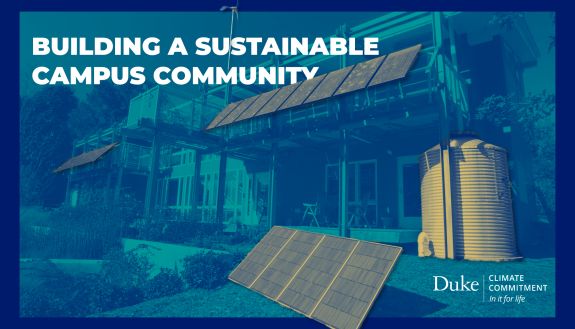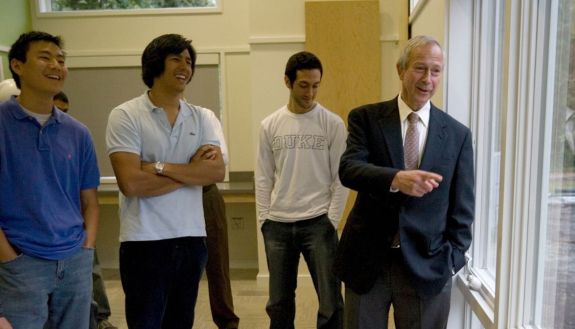Over a Decade’s Worth of Offset Work Yields High Quality Outcomes
Ethical, responsible carbon offsets are a full-time job for Duke team

Duke was able to reach its carbon neutrality goal this year because of a longstanding commitment to investing in efficient campus infrastructure and securing high-quality carbon offsets to reduce remaining greenhouse gas emissions. Since 2009, the University has had staff dedicated to the creation and implementation of the offset strategy. They specialize in researching and finding ethical, high-quality offsets -- from Durham to Bangkok.
To meet the carbon neutrality goal in 2024, Duke retired 232,000 offset credits amassed over a decade by multiple projects. The university ended up cashing in more credits than had been planned because of delays in getting an off-campus solar farm online. When that 101 megawatts of solar comes online 2025, it will meet half of the campus’ electricity needs and cut the carbon footprint for electricity in half.
“Carbon offsets are abstract things that represent greenhouse gases that have been removed or avoided from being released into the atmosphere,” said Matthew Arsenault, assistant director of carbon and sustainability operations in the Office of Climate and Sustainability.
Each offset credit represents one metric ton of avoided greenhouse gas emissions. Each credit is tracked with a serial number to ensure the offset’s chain of custody. Third party verification firms confirm that the offset project follows the required protocol and proper accounting processes.
Duke paid an average of $17 per offset credit across its entire portfolio, making the 232,000 credits worth nearly $4 million.

Duke's banked offset credits are a way to neutralize emissions from campus activities that could not be reduced. From the very beginning, Duke has included what are known as scope 3 emissions, like commuting and air travel, in its climate goals — a distinction that sets it apart from many peers. Including scope 3 emissions increased the need for offsets for these difficult-to-reduce emissions. Many other institutions that made climate goals have left these more challenging categories out of their calculations for now.
Duke had the first university-based offset credits office which since 2009 has researched dozens of possible offset projects and even invested in small-scale pilot projects of its own. These include swine waste-to-energy, residential energy efficiency, urban tree plantings, regenerative animal grazing, and residential solar, all of which provided research opportunities for students and faculty and strengthened relationships with local organizations and community members. However, these projects proved difficult for the university to scale and manage in a way that made financial sense.
From the very beginning, Duke has included what are known as scope 3 emissions, like commuting and air travel, in its climate goals — a distinction that sets it apart from many peers. Including scope 3 emissions increased the need for offsets for these difficult-to-reduce emissions. Many other institutions that made climate goals have left these more challenging categories out of their calculations for now.
Duke’s first major offsets project was a hog farm west of Yadkinville where methane captured from the hog waste was turned into renewable electricity in a partnership between Duke University, Duke Energy, and Google. This university project led to multiple published papers in collaboration with Marc Deshusses, professor of Civil and Environmental Engineering at Pratt School of Engineering, and the founding director of the Duke Carbon Offsets Initiative, Tatjana Vujic, Adjunct Assistant Professor in the Nicholas School of the Environment. This waste-to-energy project was foundational in Duke’s efforts to understand the complexity of carbon offsetting and the carbon market.
While Duke has piloted other offset projects, particularly urban tree planting, the University transitioned away from running its own projects as it neared 2024 to focus on projects with greater volume and quality to meet the carbon neutrality goal. To ensure that Duke is purchasing the highest-quality offsets, the Office of Climate and Sustainability developed a rigorous evaluation framework. This framework, along with subject matter experts across the university, is used to assess any offset project that Duke considers purchasing.
The Duke carbon offsets team is often called upon to advise other peer universities because of their depth of knowledge around the voluntary offset market and custom evaluation tool.
One of the university’s largest sources of offset credits currently is based in both Bowling Green, Ohio and Bangkok, Thailand. They are created by a company that is destroying refrigerants called HCFCs (hydrochlorofluorocarbons) before they leak into the atmosphere.
“These are really potent greenhouse gases that are stored in these cylinders in warehouses around the world,” Arsenault said. “There are stockpiles, and they're slowly leaking into the atmosphere, some of them with a global warming potential of more than 1,000 times that of carbon dioxide.”
The key variable in a responsible carbon offset is called “additionality,” meaning the reductions in greenhouse gas emissions would not have occurred without this project. The project must genuinely contribute to reducing carbon emissions beyond what would have happened in the normal course of activities.
Beyond 2024, Duke is focusing its efforts on reducing on-campus emissions through even deeper investment in sustainable infrastructure and renewable energy to reduce energy emissions. It will also focus on fostering changes in commuting and air travel behaviors. The eventual goal is to reduce Duke’s reliance on carbon offsets.
"We're using what is called the carbon management hierarchy,” said Duke’s director of climate and sustainability Lindsay Batchelor. “You first reduce emissions on campus through energy efficiency and infrastructure upgrades. Then you replace non-renewable fuels with renewable sources. Offsets are the last solution once you don't have any other options.”
A Sample of Duke's Carbon Offsets
Duke has been researching, developing, and investing in carbon offset projects for 15 years through ambitious pilot projects, community partnerships, and carefully selected commercial agreements. The following provides a glimpse into several key project areas.
Landfill Methane Gas Destruction
Duke purchased offsets from the Flathead Landfill in Kalispell, Montana, which captures methane emitted by the landfilled waste and runs it through a generator to create renewable electricity. This collaboration with the Flathead Electric Cooperative enabled them to build the first methane gas-to-energy project in the state and to power 1,600 homes. The co-op has pre-established energy cost guidelines that make this project feasible only with the sale of carbon offsets.
Waste to Energy
More than a decade ago, Duke designed and piloted a system just west of Yadkinville, N.C. to capture swine waste and convert it to electricity that was fed to the grid. It served as a research site for Duke faculty and students and provided a model for reducing the methane impacts of animal agriculture in North Carolina. Using what Duke learned in North Carolina, it has purchased offsets from three family dairy farms in Washington that are destroying the methane from cow manure using a similar system to create carbon offsets.



Ozone Depleting Substance (ODS) Destruction
In Ohio and Thailand, a firm called Tradewater is searching out and destroying stockpiled refrigerant gases that would otherwise leak into the atmosphere and contribute to climate change. There are very few, if any, incentives to address these leaking stockpiles other than through carbon offset projects. The refrigerants that are destroyed have a climate warming potential near 1,000 times greater than carbon dioxide. More charismatic or photogenic projects tend to get the headlines, but preventing some of the most powerful greenhouse gases from entering the atmosphere is a necessary part of any solution to climate change.
Forestry
In partnership with the City of Durham and Keep Durham Beautiful, Duke University’s urban forestry program has planted more than1,000 trees in Durham. These trees will continue to grow along streets in Durham and sequester carbon throughout their lifetimes. Duke also partnered with 12 indigenous communities in the southern state of Oaxaca, Mexico that employ sustainable forestry to conserve soil, water, and biodiversity while sequestering carbon. The Nicholas School has led field courses and masters research projects with Duke students and worked with the community to develop new ways to support conservation, including discouraging illegal logging and practicing sustainable forestry to create carbon credits.
RELATED STORIES ON DUKE CARBON NEUTRALITY


